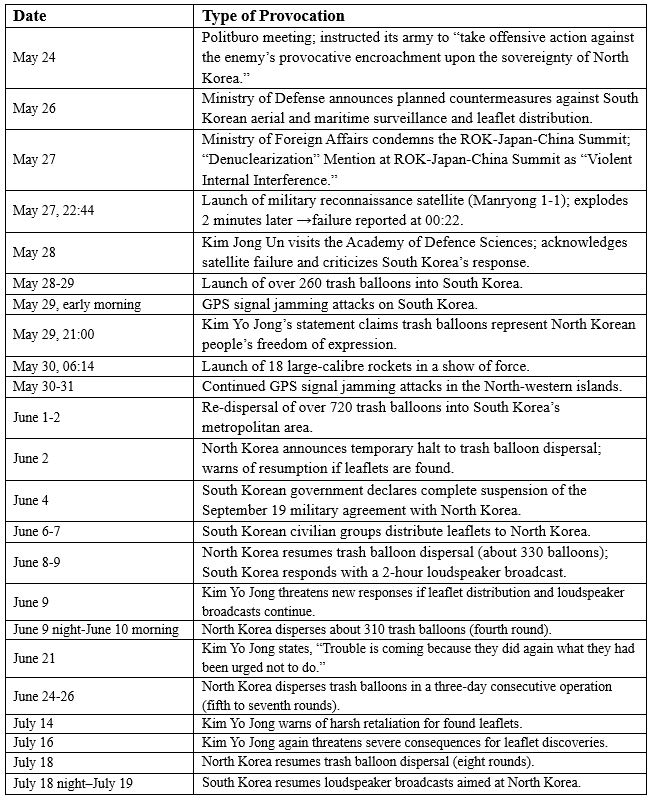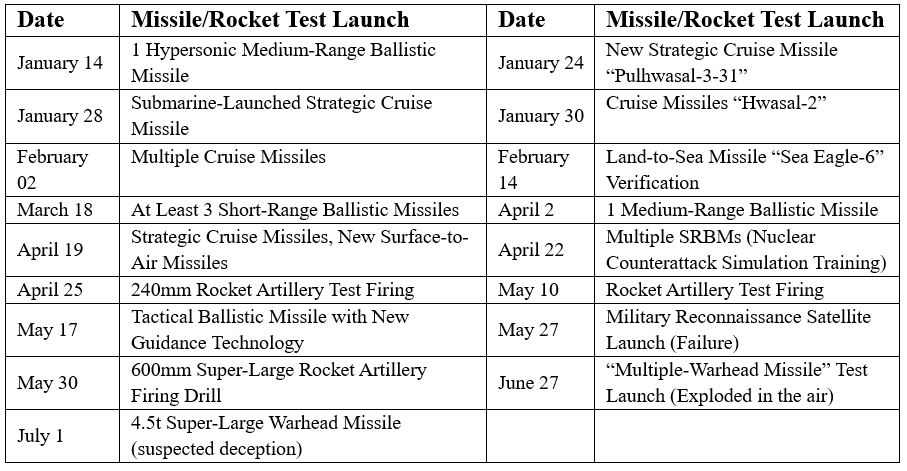This article analyzes and evaluates North Korea’s provocations against South Korea in the first half of 2024 and assesses the likelihood of further provocations in the second half of the year. As of July 18, North Korea has threatened further provocations, including additional trash balloon launches, indicating that provocations will intensify in the second half of the year. Likely provocations could occur around three time periods: (1) the Ulchi Freedom Shield (UFS) ROK-U.S. combined military exercises in August; (2) the declaration of North Korea’s own “maritime border” through constitutional amendments in the Supreme People’s Assembly in September; and (3) the U.S. presidential election in November.
North Korea’s objective is likely to focus on steering international public opinion in favor of recognizing North Korea as a “nuclear weapons state.” North Korea’s provocations might escalate from conventional to nuclear threats against South Korea. This could potentially include additional nuclear tests and the launch of intercontinental ballistic missiles (ICBMs) or submarine-launched ballistic missiles (SLBMs). However, as North Korea focuses more on severing relations with the South, and seeks to resume dialogue with a potential second Trump administration while undertaking many internal tasks, the incentives for provocations are expected to decrease compared to previous years. Nevertheless, the possibility of gray zone provocations remains.
1. Missile Tests in the First Half of the Year
In the first half of this year, North Korea continued missile tests, showing a pattern similar to last year. However, unlike last year, when it focused on showcasing various missile threats from anywhere at any time, this year saw fewer mass launches and more frequent tests for developing new weapons.
Figure 1. DPRK Missile (Rocket) Test Launches (January-July 2024)
2. Development of Provocations Against South Korea in the First Half of the
This year, North Korea’s provocations against the South started with the launch of a new military reconnaissance satellite on the night of May 27. The following day, North Korea began launching trash balloons toward South Korea. On May 29, North Korea started GPS jamming attacks, and on May 30, it launched 18 super-large multiple rocket launchers. On June 2, North Korea declared a temporary suspension of the distribution of trash balloons. During this process, the South Korean government suspended the entire September 19 inter-Korean military agreement on June 4. From June onwards, North Korea resumed the release of trash balloons toward the South.
2.1 Provocation Warning: Politburo Meeting (May 24) and Vice Minister of Defense’s Statement (May 26)
Since the end of May, North Korea’s provocations against the South were decided at the May 24 Workers’ Party Politburo meeting, included responses to perceived sovereignty infringements. On May 25th, the Rodong Sinmun reported that the Political Bureau meeting “listened to a comprehensive report from the General Staff of the Army on the recent military situation” and “presented the ‘immediate military activity tasks’ of the Republic’s armed forces to safeguard the state’s sovereignty and security interests.” The next day, North Korea’s Vice Defense Minister Kim Kang Il vowed to scatter “mounds of wastepaper and filth” over the inter-Korean border areas in retaliation against anti-Pyongyang leaflets.
2.2 Satellite Launch (May 27) and Mass Rocket Launch (May 30)
The satellite launch coincided with a ROK-Japan-China trilateral summit. North Korea condemned this and called it “wanton interference” in North Korea’s internal affairs. On May 27, North Korea launched a military reconnaissance satellite, which failed. Kim Jong Un encouraged continued efforts despite the failure and criticized South Korea’s military drills. On May 30, North Korea conducted a “600mm super-large multiple rocket launcher” demonstration targeting South Korea.
2.3 Dispatch of Trash Balloons and GPS Jamming (May 28-June 2)
Between May 28 and June 2, North Korea sent about 1,000 trash balloons to South Korea in response to South Korean defector groups releasing balloons and as a broader effort to pressure South Korea. Concurrently, North Korea engaged in GPS jamming attacks, totaling around 1,500 incidents affecting South Korean signal monitoring systems.
2.4 Resumption of Trash Balloon Dispatchment and Threat of “New Response”
(June 8–July 18)
After defector groups resumed dispersing anti-North Korean leaflets, North Korea responded by sending trash balloons to South Korea from June 8-9. North Korea threatened to send ‘a hundred times the amount of trash’ if leaflet dispersal continued. In response, South Korea reactivated loudspeaker broadcasts on June 9. Kim Yo Jong warned of a new response if both leaflets and broadcasts continued, but the escalation remained limited to additional balloon dispersals. North Korea’s stance showed a defensive posture, possibly due to upcoming diplomatic events and South Korea’s flexible response. Balloon dispersals continued intermittently, with eight instances reported by July 18.
Table 2. North Korean Provocations Against South Korea (May 24–July 18, 2024)

2.5 Characteristics of North Korea’s Provocations in the First Half of the Year
First, North Korea’s provocations toward South Korea have somewhat decreased in intensity. While last year’s first half featured aggressive demonstrations of nuclear capabilities, this year saw a focus on new weapon development with occasional large-scale artillery tests. Second, provocations after late May fall into two categories: (1) a week-long series of complex provocations from May 27 and June 2 aimed at pressuring South Korea, and; (2) a “balloon war” from June 6 to July 18. Both categories involve a “balloon war”, but they differ in nature. The former was a hybrid of military and non-military tactics, while the latter was a tit-for-tat response. Third, the main provocation method in the first half involved typical North Korean gray zone tactics, GPS signal jamming and trash balloon dispersal are typical examples of North Korea’s gray zone strategies. Although these might seem less severe than nuclear tests or ballistic missile launches, their psychological and moral impact on the public and military can be significant.
3. Outlook for Provocations against South Korea in the Second Half of the Year
3.1. Motivation for Provocations
North Korea will likely conduct a military drill in response to the upcoming ROK-U.S. joint exercises Ulchi Freedom Shield (UFS) in August. The UFS is scheduled to include military measures simulating a North Korean nuclear attack, marking the first time nuclear operation exercises will be conducted, which will likely cause North Korea to react more sensitively. Provocations against the South in the Northern Limit Line (NLL) area also seem inevitable if North Korea changes its constitution to define its own maritime border. In addition, if Trump, unlike his first term, focuses on pressure rather than engagement with North Korea, Kim Jong Un might retaliate with provocations, but this possibility does not seem very high. However, if Trump’s North Korea policy remains centered on “denuclearization,” North Korea might seek to transition to nuclear arms reduction talks by demonstrating its capabilities through nuclear missile provocations.
3.2. Level and Type of Provocations
North Korea will likely hold South Korea as a nuclear hostage to foster public opinion in the U.S. that supports managing North Korea (nuclear freeze) rather than denuclearization. If North Korea seeks to change the status quo through provocations, it will engage in an escalating pattern of complex provocations, starting from low intensity and moving to high intensity. South Korea must prepare for the possibility of North Korea’s maximum provocations. The maximum level of provocations could involve “MDL/NLL gun and artillery provocations à declaration of a quasi-state of war + threat of missile strikes on Guam against the U.S. à additional nuclear tests + ICBM/SLBM launches.” There is also the possibility of a seventh nuclear test.
3.3. Factors for Restraint in Provocations
In a situation where improvement in relations with China is necessary, there would be no reason for North Korea to unnecessarily escalate and create tension. North Korea is likely to continue gray zone provocations against South Korea but will refrain from high-intensity provocations targeting the U.S. Another burden for provocations is the numerous internal issues North Korea needs to address.
4. Conclusion and Policy Implications
This year, North Korea’s internal and external policy directions have fluctuated significantly. Several incidents of provocations against South Korea are anticipated in the latter half of the year. However, the likelihood of Kim Jong Un undertaking reckless, high-intensity provocations seems reduced compared to the past. This is because the North Korean authorities have been focusing on numerous internal tasks—including constitutional amendments, regional industrial development—and external tasks—such as strengthening ties with Russia, gaining recognition as a nuclear state—which makes provocations appear secondary. Certain levels of provocations are inevitable, especially during the ROK-U.S. UFS (Ulchi Freedom Shield) exercises. However, determining whether such provocations are aimed at severing relations or merely a responsive measure will reveal Kim Jong Un’s true intentions regarding his policy shift towards South Korea.
In addition, even though Kim Jong Un stated that North and South Korea were no longer the same people, South Korea should seek policies that embrace North Korea as one people. While it is important to inform the closed North Korean society with objective facts, it should also be cautious of actions that could escalate tensions unnecessarily. It is doubtful whether emotionally charged leaflets slandering the regime will have desirable effects.
Finally, in addition to managing immediate provocations, South Korea should focus on long-term strategies that address both internal and external challenges. This includes preparing for potential chemical and biological threats from North Korea through comprehensive civil evacuation drills and public education. Only when the people and the government are prepared to face war can any provocation from North Korea be thwarted.
This article is an English Summary of Asan Issue Brief (2024-18).
(‘2024년 상반기 북한의 대남 도발 평가 및 전망’, https://www.asaninst.org/?p=94843)

 Facebook
Facebook Twitter
Twitter
